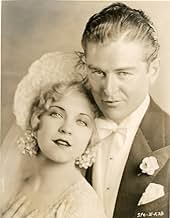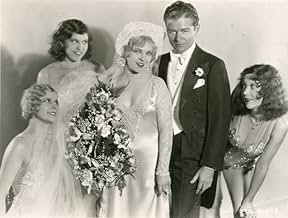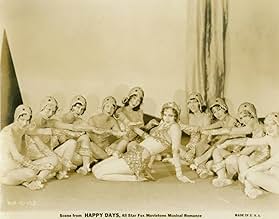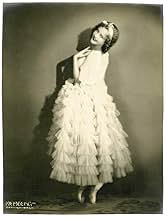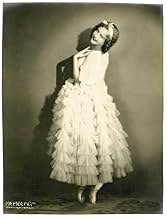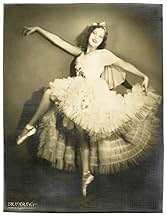In Fox's contribution to the all-star revue cycle of early talkies, showboat singer Margie, hearing that the show is in arrears, goes to New York to gather all of the former stars to stage a... Read allIn Fox's contribution to the all-star revue cycle of early talkies, showboat singer Margie, hearing that the show is in arrears, goes to New York to gather all of the former stars to stage a minstrel show as a benefit.In Fox's contribution to the all-star revue cycle of early talkies, showboat singer Margie, hearing that the show is in arrears, goes to New York to gather all of the former stars to stage a minstrel show as a benefit.
- Awards
- 2 wins total
Featured reviews
Fanatics will have to see this. People who just like early show business more or less will find much to enjoy with their finger hovering over the fast forward button.
The black face minstrelsy is probably 100% authentic given how many people involved with it in the 19th century were probably associated with this production. The ad-libbing by the Broadway crowd when the plot is being laid out is kind of dull, but may be an authentic replica of how those guys talked. George Jessel is making it up as he goes along and is not at his wittiest. But you get to see how the guys who seemed to be having all the fun dressed, walked, spoke, emoted, and loved each other.
The familiar now obsolete acts are here: burlesque of "high-class" dancers, heavy-accented "Yiddish" monologist, meek man with much taller over bearing wife, and so on. Come to think of it, this stuff never goes away entirely.
Correction to an earlier reviewer: the sets do make sense because if you listen to the set-up the show is in a theater, not on the show boat (remember, Jessel asks the theater owner if his theater is "dark", meaning is it unoccupied so this fund raiser can be presented in it).
It thankfully ends with the entire company taking a bow, and you silently applaud them up in Show Business Heaven.
The black face minstrelsy is probably 100% authentic given how many people involved with it in the 19th century were probably associated with this production. The ad-libbing by the Broadway crowd when the plot is being laid out is kind of dull, but may be an authentic replica of how those guys talked. George Jessel is making it up as he goes along and is not at his wittiest. But you get to see how the guys who seemed to be having all the fun dressed, walked, spoke, emoted, and loved each other.
The familiar now obsolete acts are here: burlesque of "high-class" dancers, heavy-accented "Yiddish" monologist, meek man with much taller over bearing wife, and so on. Come to think of it, this stuff never goes away entirely.
Correction to an earlier reviewer: the sets do make sense because if you listen to the set-up the show is in a theater, not on the show boat (remember, Jessel asks the theater owner if his theater is "dark", meaning is it unoccupied so this fund raiser can be presented in it).
It thankfully ends with the entire company taking a bow, and you silently applaud them up in Show Business Heaven.
Pleasant enough early musical from 1930. Catchy but unfamiliar songs and well staged musical numbers. As is usual with these revues, many of the studio's contract players appear, mostly playing themselves. However, their two top stars, Janet Gaynor and Charles Farrell, have a number of their own. There is a storyline of sorts but this is only at the beginning, and, from about a third of the way through, the film is "All Dancing, All Singing and All Pretty Dreadful Jokes!!". There is no cast list but stars like Warner Baxter and Will Rogers are easily recognisable. Best part of the film is the closing number in which most stars and most of the film's songs are seen and heard again. Best performance is by Marjorie White - although she has about the only acting part in it. No Technicolour sequences but I believe the film was originally shot in some wide screen process. If you like early musicals, this one is, for the most part, fair. But see it if you can as it has it's moments.
Correction. A cast list does appear just before the start of the musical numbers. I obviously missed this during the first viewing!
Correction. A cast list does appear just before the start of the musical numbers. I obviously missed this during the first viewing!
I refer to one of the cast in the chorus (as far as I know), Harry Lauder. You have flagged him up as the famous Scottish Variety Theatre singer, but that is incorrect. It was not Sir Harry Lauder, who was 60 in 1930.
The Harry Lauder (10 Nov 1902, Hamilton, Lanarkshire, Scotland, - 5 Dec 1951, Sydney, Australia, youngest surviving son of Matthew Currie Lauder) who appeared in "Happy Days" was Sir Harry's nephew, and also named Harry.
Harry II, as he liked to be known, was a child musical prodigy with a rich tenor's voice. Following The Great War his famous uncle, Sir Harry Lauder, sent him to Europe for a musical education, including Milan and Paris, where he had vocal training, and he subsequently sang in minor roles in Paris and Britain in Puccini and light opera. He then went to Chicago, U.S.A., where he appeared with the opera company, also undertaking training as a conductor. He then joined the U.S. Gilbert & Sullivan Rep.Co., and toured widely (notably in Richmond, Virginia.), both singing and conducting.
He subsequently conducted Fox Movietone News for 18 months before William Fox suggested he come to Hollywood to work for him there. He then moved to Los Angeles and set up a teaching studio in Glendale. It is unclear what he did for Fox in Hollywood, although he took minor roles in "Happy Days" (1930) (chorus) and several other Fox films, which seem to have gone largely unnoticed.
The Harry Lauder (10 Nov 1902, Hamilton, Lanarkshire, Scotland, - 5 Dec 1951, Sydney, Australia, youngest surviving son of Matthew Currie Lauder) who appeared in "Happy Days" was Sir Harry's nephew, and also named Harry.
Harry II, as he liked to be known, was a child musical prodigy with a rich tenor's voice. Following The Great War his famous uncle, Sir Harry Lauder, sent him to Europe for a musical education, including Milan and Paris, where he had vocal training, and he subsequently sang in minor roles in Paris and Britain in Puccini and light opera. He then went to Chicago, U.S.A., where he appeared with the opera company, also undertaking training as a conductor. He then joined the U.S. Gilbert & Sullivan Rep.Co., and toured widely (notably in Richmond, Virginia.), both singing and conducting.
He subsequently conducted Fox Movietone News for 18 months before William Fox suggested he come to Hollywood to work for him there. He then moved to Los Angeles and set up a teaching studio in Glendale. It is unclear what he did for Fox in Hollywood, although he took minor roles in "Happy Days" (1930) (chorus) and several other Fox films, which seem to have gone largely unnoticed.
When the showboat she performs on is threatened with repossession, Marjorie heads to New York where she persuades all the stars there -- which seems to be the list of Fox contract players -- to perform in a minstrel show to lift the mortgage.
Yes, much of it is in blackface. Performers in solo and specialty numbers have the make-up removed, and the last twenty minutes or so is performed without the hated shoe polish. This is a good one, not for the number in which Edmund Lowe and Victor Mclaglen sing about how they really like each other, or for Charles Farrell and Janet Gaynor singing the forgettable "We'll Build A World Of Our Own." But Broadway star Charles MacFarlane has a fine singing voice; Tom Patricola does a dynamite eccentric dance; and to watch Ann Pennington and Sharon Lynne dance "Snake Hips" in very revealing costumes is a treat.
This was the second movie shot in Fox's Grandeur Process, an early 70mm format. Unhappily, the copies at are available are in standard format and rather blurry. But there are some surprising techniques, like a Busby Berkeley shot and extended sequence of single dancers in full body length, well before these techniques became standard.
It's one of those movies that the major studios made in this brief period, showing off their stars in song and dance, whether they could sing, dance or not. Given the inherently mixed bag nature of the genre, this is a pretty good example of the revue format.
Yes, much of it is in blackface. Performers in solo and specialty numbers have the make-up removed, and the last twenty minutes or so is performed without the hated shoe polish. This is a good one, not for the number in which Edmund Lowe and Victor Mclaglen sing about how they really like each other, or for Charles Farrell and Janet Gaynor singing the forgettable "We'll Build A World Of Our Own." But Broadway star Charles MacFarlane has a fine singing voice; Tom Patricola does a dynamite eccentric dance; and to watch Ann Pennington and Sharon Lynne dance "Snake Hips" in very revealing costumes is a treat.
This was the second movie shot in Fox's Grandeur Process, an early 70mm format. Unhappily, the copies at are available are in standard format and rather blurry. But there are some surprising techniques, like a Busby Berkeley shot and extended sequence of single dancers in full body length, well before these techniques became standard.
It's one of those movies that the major studios made in this brief period, showing off their stars in song and dance, whether they could sing, dance or not. Given the inherently mixed bag nature of the genre, this is a pretty good example of the revue format.
This film, which was just another musical in that crowded time of 1929-30, is truly dreadful to experience today. ANY of the musicals done by the other studios during this time would have been better. Charles Farrell and Janet Gaynor do a horrible number guaranteed to rot your teeth from all the sugar. Why Fox insisted on putting Frank Richardson in a musical is anybody's guess. A hideous shrieking screeching singer who could give a deaf person a headache. A few of the chorus numbers are okay, but pale next to the work in films like King of Jazz or Show of Shows. This was originally filmed in the early wide-screen process "Grandeur", but now is seen in an old dupe like the vastly superior Just Imagine from the same studio. I like Charles Farrell as Gale Storm's father in My Little Margie, and Janet Gaynor in the terrific A Star Is Born from 1937, but together, they may have been part of the reason for the big backlash against musicals in 1930. They are.......Icky!
Did you know
- TriviaThe second film released in 70mm widescreen (La piste des géants (1930) was the first).
- Alternate versionsFilmed and released in two versions: standard (35 mm) and widescreen in the Grandeur process (70 mm). For its premiere showing, the widescreen version played at the Roxy Theatre in New York City, and was the first film ever shown entirely in widescreen. No print of the widescreen version is known to exist.
- ConnectionsFeatured in Biography: Betty Grable: Behind the Pin-up (1995)
- SoundtracksWe'll Build a Little World of Our Own
(uncredited)
Music by James F. Hanley
Lyrics by James Brockman
Copyright 1930 by Red Star Music Co. Inc
Performed by Janet Gaynor and Charles Farrell
Details
- Runtime
- 1h 20m(80 min)
Contribute to this page
Suggest an edit or add missing content

